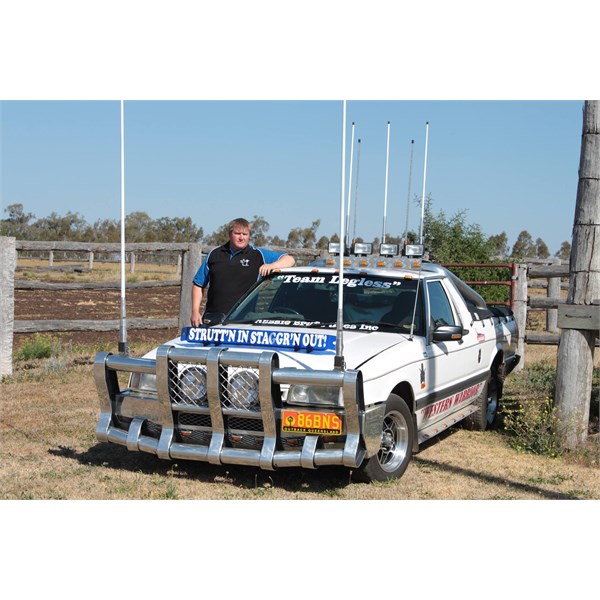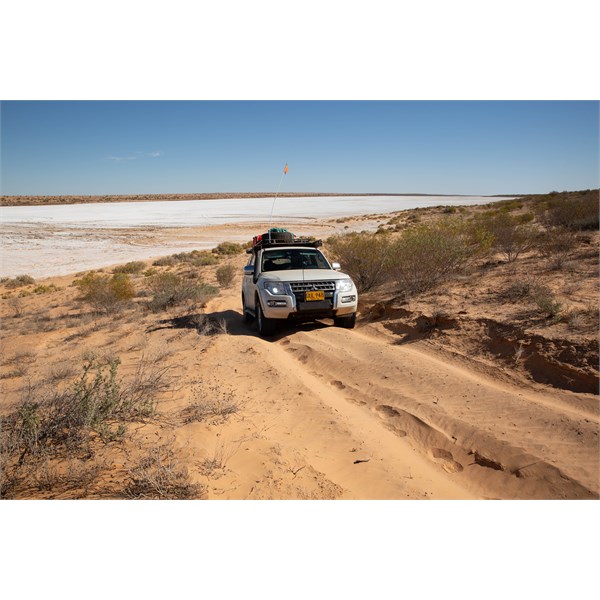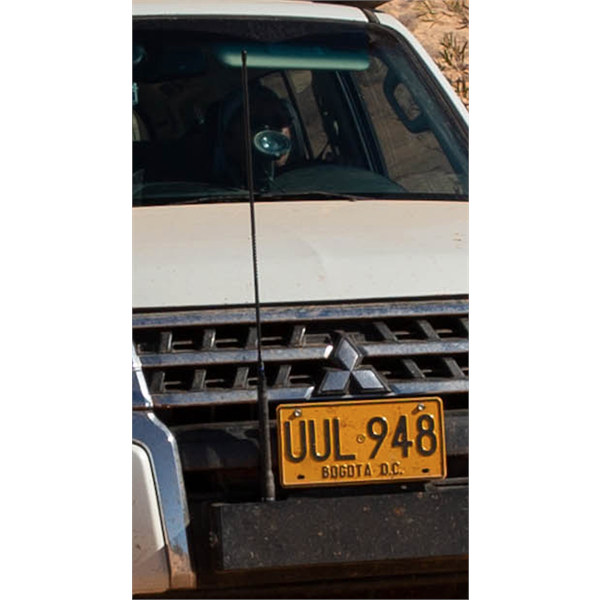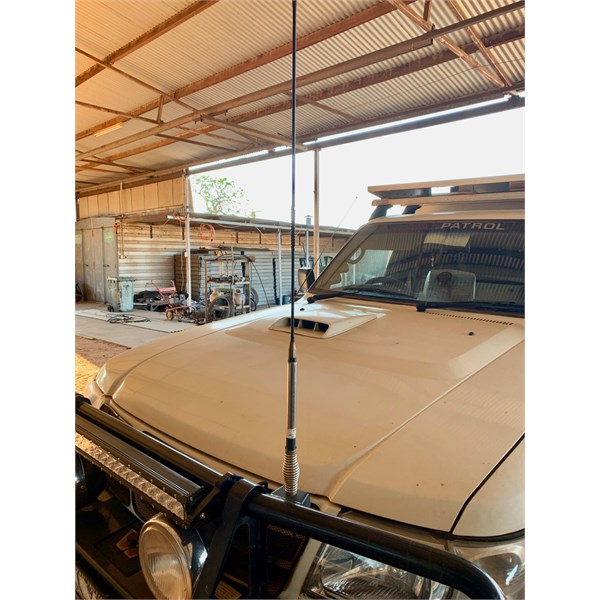Are the big thick UHF antenna better than the thinner ones?
Submitted: Wednesday, Oct 28, 2020 at 13:50
ThreadID:
140685
Views:
21991
Replies:
12
FollowUps:
14
This Thread has been Archived
Member - Richard N4
Need to replace the antenna on the bull bar as the last one snapped but not before it wore away the thread on the base rendering it useless.
Been looking at the twin pack options from Uniden,
https://uniden.com.au/product/atx970-twin/https://uniden.com.au/product/at886bk-twin/
The specs read very similarly however the main difference I can see is the thicker one is a fair bit taller (and heavier) and also costs more so going by the "you get what you pay for" it might perform better?
I'm leaning towards the thinner one but had one break on a trip a while ago. It didn't have a brand on it so suspect it was a cheaper option which came with 4x4. But if the larger one will offer better performance, then I'd be happy to wear the hard time I'm likely to receive ........ :-)
Reply By: ExplorOz Team - Michelle - Wednesday, Oct 28, 2020 at 13:55
Wednesday, Oct 28, 2020 at 13:55
I've linked one of our articles to this post (just editted as I posted the wrong one at first), and for your convenience have cut/pasted the relevant parts here.
The general rule of thumb when it comes to antennas is the higher the frequency the smaller the antenna. A good example is the antenna size of a mobile phone, which uses nearly twice the frequency of a
UHF Radio. Good antenna performance is important because it can assist your reception and transmission greatly. Antennas are also be made to have gain, which will increase the Effective Radiated Power (ERP) of the CB.
Helical Whip
The wavelength of 477MHz is around 62cm and the length of the antenna is very critical. This is the main reason why many 477MHz “Whips” usually come out of the factory pre-tuned. The most basic type of whip antenna is the quarter wave ground plane, which are about 15cm in length and are made of stainless steel or wire, for more flexibility. These relatively small antennas have a naturally high angle of radiation and are best used in hilly countryside. They work
well with repeaters because they are ideal for carrying the signal from a low point such as your vehicle to a high point where the repeater may be situated.
Gain
A 4.5 to 6 dB gain antenna is great for all types of terrain and is suitable for most situations. Gain is measured in decibels (dB) and the higher the gain, the more power can be transmitted. High gain antennas usually have coils wound into the steel or fibreglass rod, increasing the length considerably. The clear advantages are that a 5 watt radio with a 6dB antenna can perform like a 20 watt radio because 6dB results in 4 times more power.
Installation
Most UHF aerials require a ground plane, which means they should be mounted on top of a metal surface. The best spot in this regard would be the centre of your roof. Unfortunately for some people, this may not be a great idea because it could require drilling through the roof for installation. Travellers also prefer to utilise their roof rack space for carrying supplies. If the roof is not on the cards, then other good locations to mount an aerial can include: the roof gutter, side guard or on the bullbar, which is probably the most common.
AnswerID:
633907
Follow Up By: Member - Richard N4 - Wednesday, Oct 28, 2020 at 14:41
Wednesday, Oct 28, 2020 at 14:41
Thanks Michelle, I do get the idea.
It was more around the make up of the actual antenna, is there a performance gain to be had with the bigger thicker item than the thinner one?
Maybe you've answered my question there and I'm not able to decipher?
FollowupID:
911023
Follow Up By: ExplorOz Team - Michelle - Wednesday, Oct 28, 2020 at 14:52
Wednesday, Oct 28, 2020 at 14:52
I can't say we've personally tested both that you link but I can say we have the thicker type, with the spring like the one you've linked. I agree, the descriptions look similar but the stainless spring base, thicker one should be the pick of the two.
FollowupID:
911024
Reply By: Swaggie - Wednesday, Oct 28, 2020 at 14:54
Wednesday, Oct 28, 2020 at 14:54
Depends where you do most your driving. Flatter areas 6db plus or 3db for hilly areas, great to have both options..
Only used RFI antennas.
http://www.radiospecialists.com.au/mobile%20antennas.htm
AnswerID:
633909
Reply By: Dusta - Wednesday, Oct 28, 2020 at 15:21
Wednesday, Oct 28, 2020 at 15:21
to actually answer your question there is no difference in performance between the two types, more that they are suited to different environments. The thinner antenna is more flexible obviously and better suited to tracks where you might have overgrown trees etc on the track and the antenna needs to bend. But then on open road it's more susceptible to wind etc and will flap about.
The thicker fibreglass antennas have more protection around the internals but also are not flexible at all and reply on the spring base to flex around objects.
What's more important than the antenna is making sure your connectors are high quality and
well terminated .
AnswerID:
633910
Follow Up By: Member - Richard N4 - Wednesday, Oct 28, 2020 at 15:55
Wednesday, Oct 28, 2020 at 15:55
Thanks Dusta, makes good sense, thanks!
Since nearly all our out and about is touring, the fibreglass option is probably the go.
I guess it might be an option to buy the thinner one and change out anyway but if I think I need it will look into that and whether it will even fit.
Good advice re the connectors etc. I was thinking of reusing the existing cable however it might be a better option to install the new cable.
Thanks again.
FollowupID:
911026
Follow Up By: Member - nickb "boab" - Wednesday, Oct 28, 2020 at 16:29
Wednesday, Oct 28, 2020 at 16:29
The problem is when mounted on B bar & on rough rd , is that not only dose the outer break but so can the wire inside even on the BIG ! ( WW) ones
FollowupID:
911030
Reply By: qldcamper - Wednesday, Oct 28, 2020 at 16:19
Wednesday, Oct 28, 2020 at 16:19
I just run an elivated feed base without a spring cause they just seem to amplify the movement on corrugations and fitted a 150mm whip antenna so a relatively low profile for short distance comms but carry the 600mm whip for times i need longer range, but have never needed it.
Seen a lot of those big chunky ones fail, seems they are more for looks rather than quality build and connections.
AnswerID:
633911
Follow Up By: Member - Richard N4 - Thursday, Oct 29, 2020 at 11:56
Thursday, Oct 29, 2020 at 11:56
Cool, thanks, it just attaches to roof? Seems to be the right place to attach for the best overall coverage if it can be done.
I can't get into car parks anyway so not really an issue and might go down the path of a folding base as
well so a roof mounted one might work
FollowupID:
911037
Reply By: Allan B (Sunshine Coast) - Wednesday, Oct 28, 2020 at 17:25
Wednesday, Oct 28, 2020 at 17:25
.
Richard, the technical merit of any UHF antenna is not in its length or diameter. It is a little more complicated than that. Thin whip antennae are no better or worse than the prominent 'broomstick' fibreglass types.
If you want resistance to impact from scrub branches then the flexible whip may be best, but if you wish to impress, as the bogan ute drivers do, then a very tall and highly visible fibreglass broomstick is the go.
One fairly reliable way of selecting anything like this is to look at what the police and emergency service vehicles are fitted with. I don't think you will find too many broomsticks. lol

Bogan UHF Antennae
AnswerID:
633915
Follow Up By: Member - Richard N4 - Thursday, Oct 29, 2020 at 11:59
Thursday, Oct 29, 2020 at 11:59
Lol, yep, I wondered if that were the case.
If there was indeed some sort of performance gain I would just wear the "
mine is bigger than yours" crap I'd likely receive :-)
FollowupID:
911038
Reply By: Iza B - Wednesday, Oct 28, 2020 at 18:55
Wednesday, Oct 28, 2020 at 18:55
The important thing in UHF antennas is the length of the active element. Good performance of a radiating element is dependent on the match between the wavelength of the frequency of the signal being transmitted or received. The physical dimensions of the antennas sold by the
shop are dependent on how the active element is packaged. Electronically, there is almost no difference in performance, thick or thin. Thin antennas are sometimes no more than a stiff wire sticking up in the air. The main issue becomes the work hardening of the metal when sitting out there on a bullbar and vibrating in accordance with the road conditions. one way to stop the vibrating is a thin shock cord back to the bull bar. The shock cord dampens the vibration.
Iza
AnswerID:
633916
Follow Up By: Member - Richard N4 - Thursday, Oct 29, 2020 at 12:55
Thursday, Oct 29, 2020 at 12:55
Shock cord from
the tip to the bull bar or wound around?
FollowupID:
911040
Follow Up By: Iza B - Friday, Oct 30, 2020 at 08:05
Friday, Oct 30, 2020 at 08:05
I suggest from about halfway up then down to the bullbar. It is all about dampening the flexing and preventing a flex point so that the concentration of forces does the work hardening. I lost two stainless steel UHF antenna before using the shock cord.
FollowupID:
911052
Follow Up By: Allan B (Sunshine Coast) - Friday, Oct 30, 2020 at 09:12
Friday, Oct 30, 2020 at 09:12
.
I solved the problem of watching my whip antenna on the bullbar oscillating like a tuning
fork by moving it to the roof.
Now I can't see it and have no idea if it's oscillating or not. lol
FollowupID:
911053
Follow Up By: Frank P (NSW) - Friday, Oct 30, 2020 at 22:01
Friday, Oct 30, 2020 at 22:01
Me too, Allan :-)
FollowupID:
911059
Reply By: Darian - Wednesday, Oct 28, 2020 at 19:17
Wednesday, Oct 28, 2020 at 19:17
If you were to contact a specialist 2way radio reseller, they can easily advise on the best antenna option for your intended usage. As mentioned above, one antenna can’t excel for all circumstances, but you can arrive at a fair compromise model that you can leave in place. I (like many) have a ground independent base that accepts screw on whips; either a shorty (150mm) for hilly terrain penetration and a longer one (600mm) for distance in open areas. As far as longevity and damage resistance goes...physics might suggest lighter whips will last longer...less mass to be thrown around ? Screw on whips are cheap enough to replace.
AnswerID:
633918
Reply By: Member - peter_mcc - Wednesday, Oct 28, 2020 at 21:24
Wednesday, Oct 28, 2020 at 21:24
I've only used the thin ones on our Prado with a spring base. Conveniently the one I wanted to use matches up almost exactly with the top of the roofrack (it's a smidge higher) so if it hits something going into a
carpark I know to stop.
I had a GME or Uniden one for a while before it broke - it lasted really
well. I got a no-name one from Repco and it broke in less than 5km of corrugated road (on the road into
Rainbow Valley near
Alice Springs). I've since changed to an Oricom one which hasn't broken (at least not yet!).
I tape up the bottom of the antenna and base so that they don't vibrate loose - a single wrap of duct tape stops it rotating.
AnswerID:
633921
Follow Up By: Member - rocco2010 - Thursday, Oct 29, 2020 at 00:03
Thursday, Oct 29, 2020 at 00:03
Nothing seems to vibrate on corrugations like an arb bullbar on a Prado.
And my thinner uhf aerials vibrated in sync and broke.
A wise traveller told me to get a suitable diameter short length of pvc pipe and drop it over the antenna. It stops the antenna wobbling and doesn’t seem to affect performance.
No more broken antennas .
Cheers
FollowupID:
911034
Reply By: Alan H11 - Thursday, Oct 29, 2020 at 03:07
Thursday, Oct 29, 2020 at 03:07

Simpson crossing 2019

Close up of UHF antenna
I have virtually no knowledge of the science, however this is what we have on our Montero, and it seems to work
well.
AnswerID:
633923
Reply By: Member - Cuppa - Thursday, Oct 29, 2020 at 07:45
Thursday, Oct 29, 2020 at 07:45
We have a Uniden thin one on the bullbar of our Patrol, which over the past 3 years has seen a *lot* of corrugations. I kept it on when I got rid of the crappy uniden UHF I had bought it 'bundled' with, in favour of a far better Icom unit. I had the new unit professionally fitted & whilst doing so looked at the 'thicker' antennae & asked the UHF man about them. Initially he said it was likely that my thin antentena would probably fall apart on the long desert tracks I was planning to take, but later in the conversation acknowledged that the thicker ones were a favourite of the 'dressed up ute' cowboys & smiled when he showed me a pink 'cowgirl' version. Rightly or wrongly I got the impression that the thicker antennae were more of an aesthetic choice.
After thousands of kilometres of outback roads & tracks the 'thin' Uniden antenna is still in one piece, still tightly bolted on (never been re-tightened) & still working just fine. It's added bonus is that when my wife & I are debating whether the current corrugations are worse or not than previously driven ones, the antenna 'dance' is an excellent indicator of just how bad they are! :)
There have been a few occasions when the antenna has been bent over by bushes & trees. I doubt the thicker ones would be so flexible.

Uniden UHF antenna
FWIW we have a Hilux we can use at our current location which has a very similar looking antenna fitted, but it's 'dance' is crazy, even on sealed but slightly bumpy roads. So much so I was compelled to check whether it's bullbar mounts were loose! (they weren't). Easy to tell the difference by feel. Our one has a *far* stiffer/stronger base spring.
AnswerID:
633926
Follow Up By: Member - Richard N4 - Thursday, Oct 29, 2020 at 12:52
Thursday, Oct 29, 2020 at 12:52
Great, thanks for the info.
Yes, pretty sure the one which came with the truck when I bought it was a cheapy and it did snap as it's "dance" was also very crazy.
FollowupID:
911039
Reply By: Member - Lyncol - Thursday, Oct 29, 2020 at 13:50
Thursday, Oct 29, 2020 at 13:50
Have a look at ZCG Scalar all they make and sell are antennas. I’ve had a SG477 on our first Prado then transferred it to the 07 model never had a problem, I’ve also sold many to farmers in our area. They are 2.1db which is more suited to flatter country, so if looking for best of both worlds go for a6 dB, 9db for hilly country.
AnswerID:
633931
Follow Up By: Dusta - Thursday, Oct 29, 2020 at 14:20
Thursday, Oct 29, 2020 at 14:20
your advice is incorrect . you want a 2dbi for hilly and a 6dbi for more effective coverage on flat terrain
FollowupID:
911041
Follow Up By: Member - Lyncol - Thursday, Oct 29, 2020 at 23:31
Thursday, Oct 29, 2020 at 23:31
Sorry, got it wrong on this one, but still have a look at ZCG scalar
FollowupID:
911050
Reply By: HKB Electronics - Friday, Oct 30, 2020 at 13:32
Friday, Oct 30, 2020 at 13:32
Have a look at the RFI website.
Size of antenna generally determines its gain, radiation pattern and power handling ability.
Flexible doesn't always mean they will handle vibration better, I have two medium sized broom sticks on my Prado bull bar and never had an issue with them. I also have a smaller VHF/UHF amateur antenna, small stainless steel whip on the mud guard and that has had the stainless steel tip fracture and break off due to vibration. Broom sticks with spring bases are pretty forgiving.
I have found the performance of a good quality broom stick to be far superior to the smaller compact units.
Personally go for the RFI units.
AnswerID:
633941